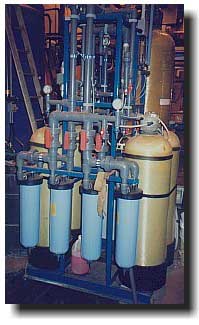Consumer-products Maker Contracts for Acid-recovery System

Problem
A major industrial manufacturer of consumer products in the U.S. Northeast had to comply with U.S. EPA water-discharge limits.
Its process waste contained significant quantities of nitric acid (HNO3), sulfuric acid (H2SO4), and soluble molybdenum compounds.
The neutralization and treatment of the process-waste streams resulted in high levels of soluble salts and molybdenum being released into the local POTW, resulting in the EPA's imposing of a fine.
Solution
The company and the EPA reached an agreement whereby the company would install a system to recover and recycle acids and process wastewater, preventing further releases.
The solution would be to design and install an acid-recovery system. The company called on Mech-Chem Associates, Inc. to provide the engineering, design, and construction of the system.
Mech-Chem designed the system to recover acid and wastewater as a closed-loop operation with zero wastewater discharge. The system was to reclaim the nitric acid, sulfuric acid, and molybdenum, as well as provide for the treatment and recycling of the process rinse waters.
The acid-recovery section would use vacuum-evaporation technology; the rinse water treatment would use ion-exchange-resin bed technology.

Ion-exchange-resin system for recovering the wastewater
The system's design called for full automation with appropriate instrumentation and controls, including three GE Fanuc 90-30 PLCs with Logic Master software. The three PLCs are integrated into one PC by a graphical user interface (GUI) developed with GE Fanuc Cimplicity monitoring-and-control software.
Technology/Treatment Used
The acid-recovery system separates the nitric acid from the sulfuric acid by evaporation using a single-effect vacuum evaporator.
The vacuum evaporator uses steam heat and has the appropriate materials of construction to handle the corrosion conditions as they vary with the changes in concentration of the acid (HNO3/H2SO4) mixture during distillation.
The sulfuric acid/water fraction (from the still bottoms) is further processed in a glass-lined pressure vessel to precipitate the molybdenum as molybdenum trioxide (MoO3). The recovered molybdenum trioxide is removed from the sulfuric acid using a solid-bowl centrifuge and sent to a metals producer to be reclaimed.
The rinse-water-cleansing and recirculation system treats about 10 mil gals/yr of contaminated rinse water using selective anion and cation ion-exchange-resin beds. After removal of the metallic and other contaminants from the rinse waters, the DI-quality water produced recycles back to the production process.
Results
The acid-recovery system has provided several significant environmental/economic impacts on the plant's operations.
- First, it has reduced the nitric and sulfuric acid purchases by 60%.
- Second, the recovery of the waste acid solution has eliminated the use of caustic (NaOH), which was required to neutralize the acid.
- Third, the recovery of the acids has eliminated the discharge of the soluble salts (that is. sodium nitrate and sodium sulfate) produced by neutralizing the waste from the production operation.
Contact: Mech-Chem Associates, Inc., Derek J. Archambault, marketing manager, 148 Main Street, PO Box 473, Norfolk, MA 02056. Tel: 508-528-5990; Fax: 508-528-8972; E-mail: info@mech-chem.com.
Edited by Paul Hersch
